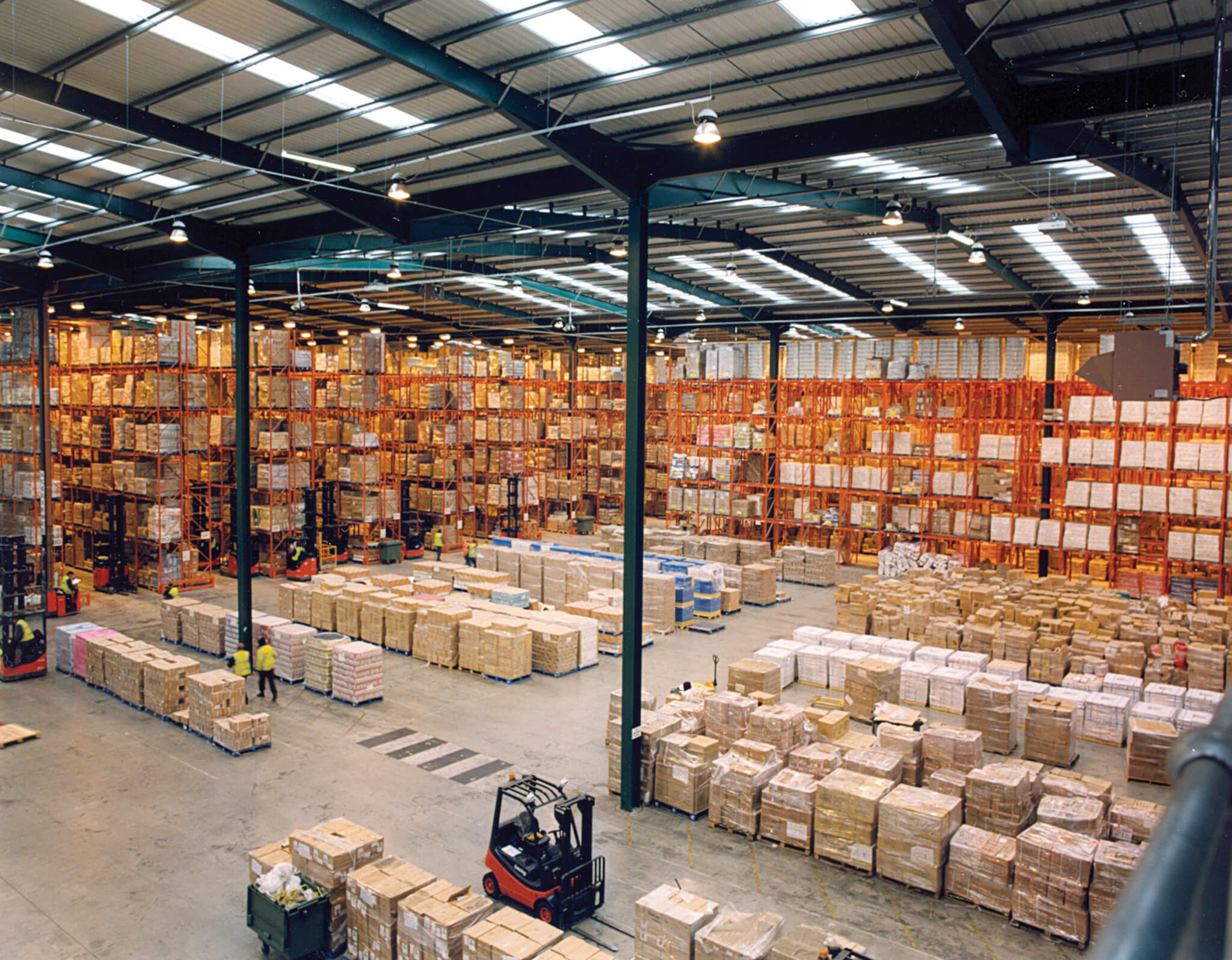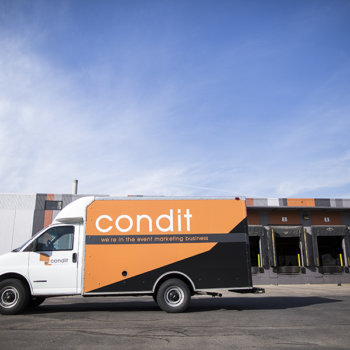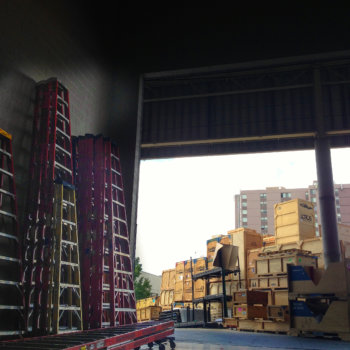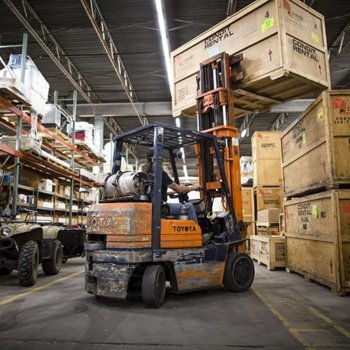When exhibiting at a trade show, convention or expo, drayage is not an optional expense. To help prevent your post-show invoice from exceeding the event budget, Condit has prepared 13 expert tips to reduce drayage costs.
-
- Know your target times and dates to avoid overtime charges.
- Learn the scheduled move in and move out dates.
- Review your material handling rates.
- Be aware of special handling.
- Understand the minimum drayage amount.
- Consolidate your shipments.
- Combine your flooring.
- Consider lighter exhibit materials.
- Pack carefully.
- Label clearly.
- Check your facts.
- Look for discounts.
- Regroup with pre-show meeting.
What is drayage?
Drayage, or material handling, is the unloading of exhibit properties, delivering properties to the booth, the handling of empties before and after the show, and reloading exhibit properties onto outbound carriers. When shipping to the advanced warehouse, this fee also includes storing exhibit properties up to 30 days in advance of the show.
Drayage varies considerably from city to city, from facility to facility, and even from show to show. At most trade shows, drayage tasks are completed by a third-party company, such as GES or Freeman, called a general contractor or “GC” for short.
The general contractor sets the pricing rates, and costs are based on the weight of the materials, move-in and move-out times, as well as the location and length of the show or event. This is an “exclusive service” that cannot be undertaken by the exhibitor or their exhibit house.
- Exhibit properties are typically delivered to and from show site via ground transportation.
- Inside crates, booth materials are unloaded at the facility as early as 30 days prior to the event.
- Drayage also encompasses the delivery of crates to the assigned exhibit space as well as storage of empty crates.
How to Reduce Trade Show Drayage
1. Know your target times and dates to avoid overtime charges.
Warehouses only accept freight between certain hours. For example, normal hours may be 8:00 am to 3:30 pm. Beyond those hours, anything after 3:30 pm or before 8:00 am would be considered overtime, which increases labor costs. Additionally, each trade show has specific arrival dates to accept inbound freight at the warehouse. If you miss these dates, you could be charged an additional 30%.
2. Learn the scheduled move in and move out dates.
Each trade show has scheduled move-in and move-out dates. Work with your transportation manager to have your exhibit moved in and out during “straight time” to save costs if possible.
3. Review your material handling rates.
Always check the event’s drayage policy before singing up to exhibit. Your exhibit kit will include several rate options from which to choose. In some instances, drayage may be included with the purchase of your booth space. There is oftentimes a difference between shipping directly to show site and shipping to the event’s advanced warehouse.
4. Be aware of special handling.
Special handling fees are incurred when exhibit materials are a non-standard size, extremely heavy, or otherwise out of the ordinary for the warehouse team. Special handling is significantly more expensive than the moving and storing of regular materials.
5. Understand the minimum drayage amount.
Typically, the minimum drayage weight is 200 lbs., but show kits will provide this figure in greater detail. Weight is often billed per 100 lbs., rounding up as needed. Some show organizers use a per pound exact rate, which can be more costly.
6. Consolidate your shipments.
To reduce costs, shipments should be consolidated to base billable costs on total weight rather than individual charges and one-off small shipments. When shipping samples or giveaways, it can be beneficial to compile your inventory together and send as one skid rather than multiple smaller shipments, which often get charged the 200 lb. minimum charge even though the box or crate is considerably lighter!. Lighter, portable modular exhibits and any last-minute add-ins should travel with the exhibitor or ship to the hotel – though in some cases, shipping to the hotel may result in hotel handling fees.
7. Combine your flooring.
Flooring handling costs extra when carpet, vinyl, etc. are shipped separately. Though it may appear to be initially less expensive to ship flooring directly from the vendor, the drayage costs are higher to receive and move these materials. It may save money to ship flooring to the client or the exhibit house to then combine with the remaining exhibit elements, which would then be transported to the warehouse or direct to show all together.
8. Consider lighter exhibit materials.
While not possible for some exhibits, depending on their particular fixtures and features, it is helpful to note in the design phase when lighter structural components are preferable to purchase or to rent. Sturdy, bulky counters are usually the heaviest item to ship, so those may be a good place to start when looking to reduce shipping weight.
9. Pack carefully.
After being received on the facility’s dock, crates and boxes are most often moved by forklift, and this can be a rough journey for unique or fragile exhibit components. At a minimum, shrink wrap, moving blankets, foam padding and varying types of tape should be utilized to prevent damage.
10. Label clearly.
Most shows provide specific labels for exhibitor crates, but a single label on such a large surface could easily be missed or could fall off in transport. Multiple copies should be affixed to each side of the crate with details provided as needed, such as marking a hanging sign for pre-assembly or noting that food samples need to be placed in cold storage. Without clear labeling, including your booth name and booth number, boxes can easily get lost within the convention center!
11. Check your facts.
Additional drayage fees are tacked on for incorrect booth number and for other erroneous details. For example, some regulations dictate that the registration must match exactly to the company name label, which could be an issue for exhibitors registering under a parent company or undergoing a name change.
12. Look for discounts.
Drayage discounts can appear unexpectedly! A recent trend includes offering the first 200 lbs. of drayage with the purchase of the floor space. Additionally, show organizers may offer discounts for meeting early arrival deadlines.
13. Regroup with a pre-show meeting.
A final regroup meeting to estimate drayage costs, review show-site contacts, circle back on event budgets, and determine how best to avoid last-minute show-site deliveries of common items like collateral, giveaways and other loose items is a valuable exercise.
Managing Drayage Costs with Condit
In our front office, Condit’s dedicated account managers understand the ins and outs of trade show drayage, working to get the best deals for clients every day. In the shop and warehouse, our crates are the best in the business, custom built for every single new project that comes through the door. Finally, at the shipping and receiving bay, our team knows how to best pack and load the trucks of our logistics partners with care and attentiveness to detail.
If you’d like to learn more about saving money on drayage or about Condit’s trade show expertise, contact us.



